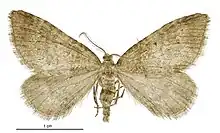| Asaphodes periphaea | |
|---|---|
 | |
| Male | |
| Scientific classification | |
| Domain: | Eukaryota |
| Kingdom: | Animalia |
| Phylum: | Arthropoda |
| Class: | Insecta |
| Order: | Lepidoptera |
| Family: | Geometridae |
| Genus: | Asaphodes |
| Species: | A. periphaea |
| Binomial name | |
| Asaphodes periphaea | |
| Synonyms[2][1] | |
| |
Asaphodes periphaea is a moth in the family Geometridae.[2] It is endemic to New Zealand and has only been collected in the mountains near Lake Wakatipu in the South Island. The male is fuscous coloured sprinkled with whitish colouration. The female is brachypterous. The preferred habitat of this species are alpine bluffs as well as mountainous open country. This species is on the wing from January to March.
Taxonomy
This species was first described by Edward Meyrick in 1905 using a specimen collected by George Hudson at Humboldt Range, Lake Wakatipu at 4000 ft and named Xanthorhoe periphaea.[3] In 1928 George Hudson discussed and illustrated this species under the name Xanthorhoe periphaea.[4] In 1939 Louis Beethoven Prout placed this species in the genus Larentia.[5] This placement was not accepted by New Zealand taxonomists.[6] In 1971 J. S. Dugdale placed this species within the genus Asaphodes under the name Asaphodes perpheraea.[7] In 1988 J. S. Dugdale confirmed this placement but perpetuated the error in the species name by using Asaphodes perpheraea when discussing this species.[2] The male holotype specimen is held at the Natural History Museum, London.[2]
Description
.jpg.webp)
Meyrick first described this species as follows:
♂ . 26 mm. Head, thorax, and abdomen fuscous sprinkled with whitish. Fore-wings triangular, termen slightly bowed, oblique ; light fuscous, sprinkled with darker fuscous and whitish ; two very obscurely darker fasciae indicating median band, first curved, preceded by several white dots, second irregularly curved outwards on upper 3⁄5, followed by a series of white dots ; some whitish dots indicating subterminal line, edged with obscure darker shades : cilia fuscous-whitish, with two fuscous lines. Hind-wings rather elongate, light fuscous ; cilia as in fore-wings.[3]
The female of this species is brachypterous and was first collected in January 1987.[8]
Distribution
This species is endemic to New Zealand.[1] A. periphaea has only been collected in the mountains in the north, west and south of Lake Wakatipu.[8] In January 1897 this species as found at Slate Basin and Jane Peak in Otago.[8]
Habitat
The preferred habitat of this species is alpine bluffs as well as mountainous open country.[8][4]
Behaviour
References
- 1 2 3 "Asaphodes periphaea (Meyrick, 1905)". www.nzor.org.nz. Retrieved 2022-01-22.
- 1 2 3 4 John Stewart Dugdale (23 September 1988). "Lepidoptera - annotated catalogue, and keys to family-group taxa". Fauna of New Zealand. Department of Scientific and Industrial Research. 14: 174. doi:10.7931/J2/FNZ.14. ISSN 0111-5383. Wikidata Q45083134.
- 1 2 Edward Meyrick (15 July 1905). "XII. Notes on New Zealand Lepidoptera". Transactions of the Royal Entomological Society of London. 53 (2): 220. doi:10.1111/J.1365-2311.1905.TB02451.X. ISSN 0035-8894. Wikidata Q54553180.
- 1 2 3 George Vernon Hudson (1928), The butterflies and moths of New Zealand, Illustrator: George Hudson, Wellington: Ferguson and Osborn Limited, p. 113, LCCN 88133764, OCLC 25449322, Wikidata Q58593286
- ↑ Prout, L. B. (1939). "Geometridae: Fauna Indo-Australica". The Macrolepidoptera of the World. 12: 264 – via Biodiversity Heritage Library.
- ↑ R. C. Craw (April 1987). "Revision of the genus Helastia sensu stricto with description of a new genus (Lepidoptera: Geometridae: Larentiinae)". New Zealand Journal of Zoology. 14 (2): 269–293. doi:10.1080/03014223.1987.10422997. ISSN 0301-4223. Wikidata Q54670161.
- ↑ J. S. Dugdale (10 November 1971). "Entomology of the Aucklands and other islands south of New Zealand: Lepidoptera, excluding non-crambine Pyralidae" (PDF). Pacific Insects Monographs. 27: 93–95. ISSN 0078-7515. Wikidata Q64006453.
- 1 2 3 4 5 A.F. Mark; K.J.M. Dickinson; B.H. Patrick; et al. (December 1989). "An ecological survey of the central part of the Eyre Ecological District, northern Southland, New Zealand". Journal of the Royal Society of New Zealand. 19 (4): 349–384. doi:10.1080/03036758.1989.10421841. ISSN 0303-6758. Wikidata Q56974942.